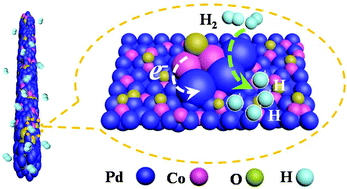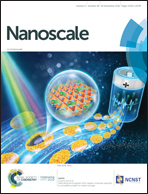Palladium/cobalt nanowires with improved hydrogen sensing stability at ultra-low temperatures†
Abstract
The metallic dopants in palladium (Pd) sensing materials enable modification of the d-band center of Pd, which is expected to tune the α–β phase transitions of the PdHx intermediate, thus improve the sensing stability to hydrogen. Here, the boosted hydrogen-sensing stability at ultra-low temperatures has been achieved with palladium/cobalt nanowires (PdCo NWs) as the sensing material. The various Co contents in PdCo NWs were modulated via AAO-template-confined electrodeposition. The temperature-dependent sensing evaluations were performed in 0.1–3 v/v% hydrogen. Such sensors integrated with PdCo NWs are able to stably detect hydrogen as low as 0.1 v/v%, even when the temperature is lowered to 273 K. In addition, the critical temperatures of “reverse sensing behavior” of the PdCo NWs (Pd82Co18: Tc = 194 K; Pd63Co37: Tc = 180 K; Pd33Co67: Tc = 184 K) are observed much lower than that of pristine Pd NWs (Tc = 287 K). Specifically, the Pd63Co37 NWs (∼37 at% Co content) sensor shows outstanding stability of sensing hydrogen against α–β phase transitions within the wide temperature range of 180–388 K, which is attributed to both the electronic interactions between Pd and Co and the lattice compression strain caused by Co dopants. Moreover, the “reverse sensing behavior” of the PdCo NWs is explicitly interpreted using the α–β phase transition model.



 Please wait while we load your content...
Please wait while we load your content...